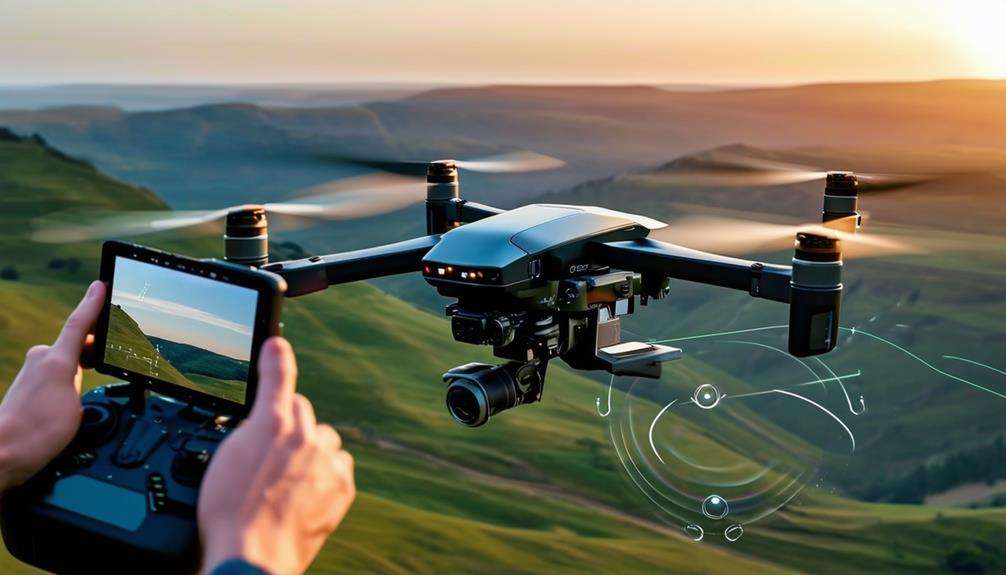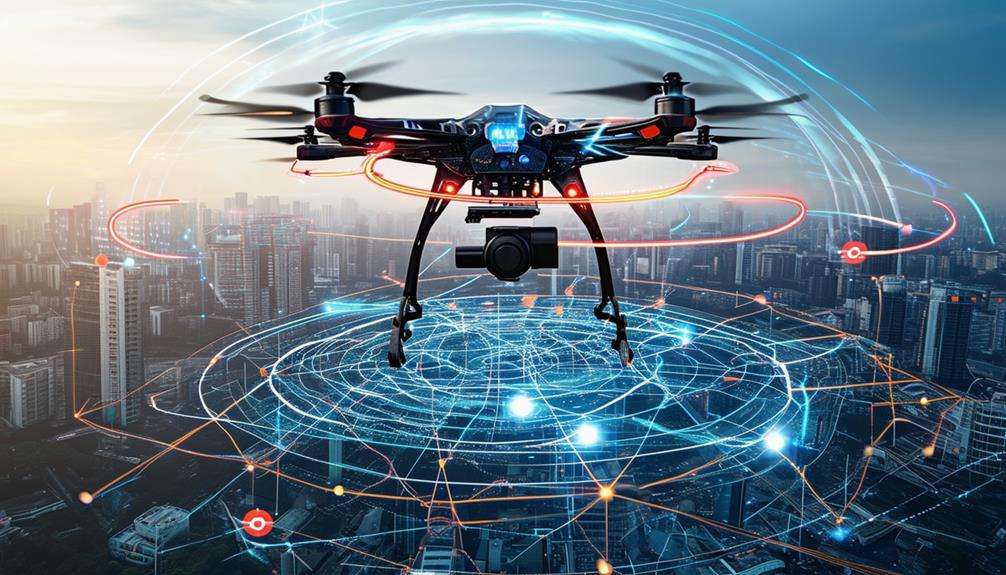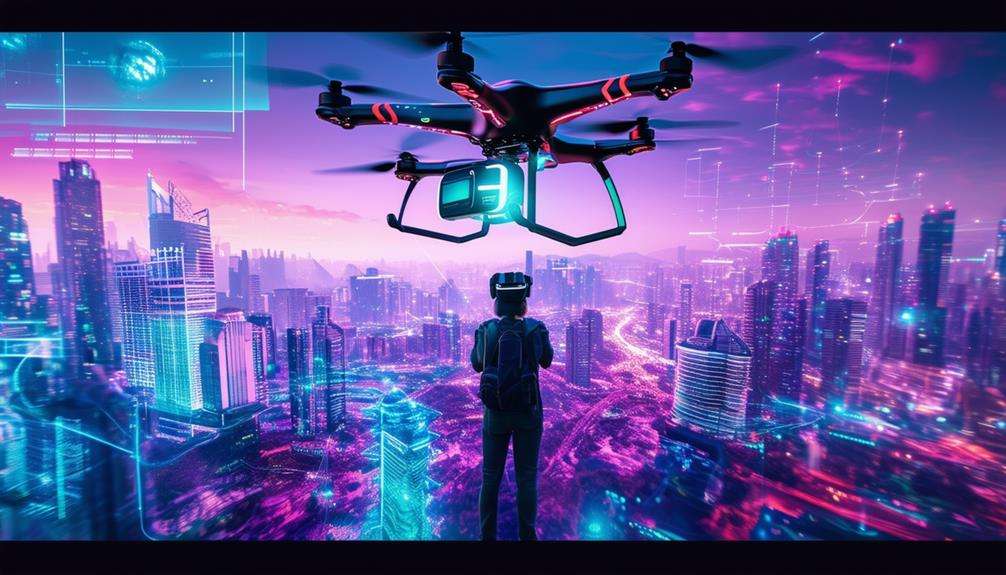Drones in Wildlife Conservation: Monitoring Endangered Species
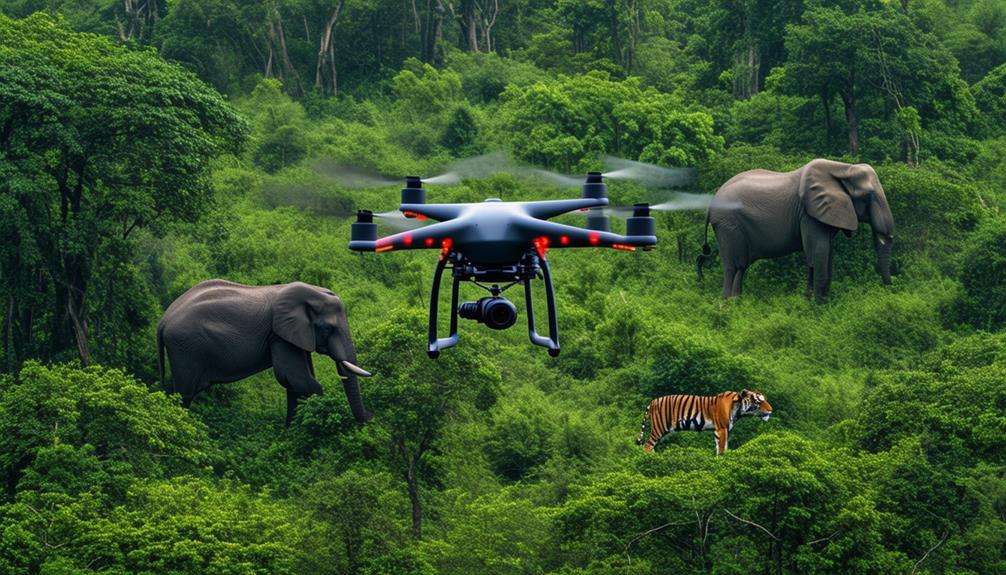
When considering wildlife conservation, drones might not be the first tool that comes to mind, but they are becoming indispensable. Drones can monitor endangered species without disturbing their natural habitats, providing a non-intrusive way to gather essential data.
Various types of drones—such as fixed-wing and multirotor models—allow for tailored approaches based on the needs of specific species and environments. These high-tech tools offer possibilities for tracking elusive animals and spotting poachers before they strike.
Thus, drones play a crucial role in preserving our planet's most vulnerable creatures.
Importance of Drones
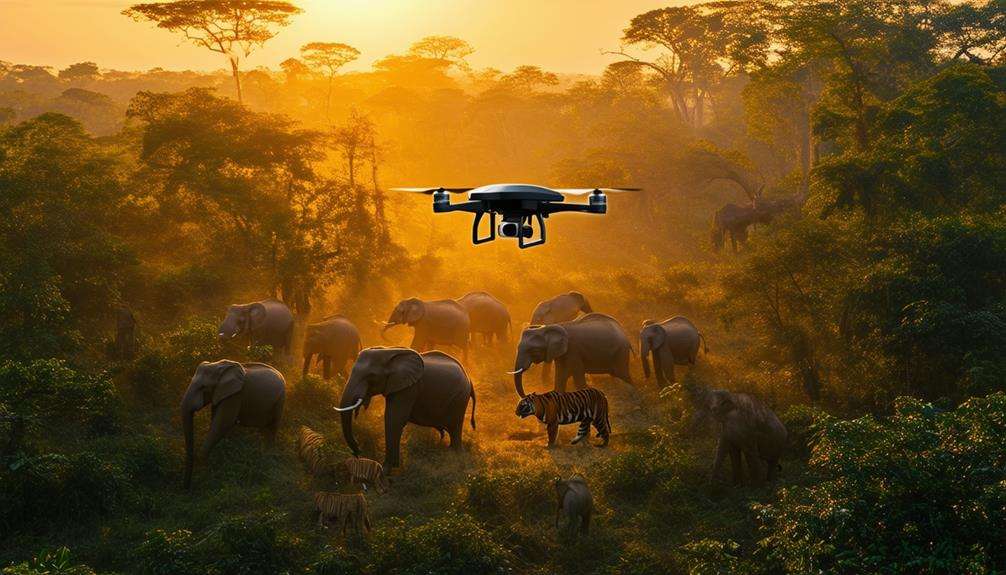
Drones play a pivotal role in wildlife conservation, offering a highly efficient means of monitoring endangered species. They enable the rapid and precise collection of critical data, significantly enhancing conservation efforts. These cutting-edge tools allow for the location, tracking, and protection of vulnerable wildlife populations more effectively than traditional methods.
Drones are particularly advantageous for studying endangered species in challenging terrains. They provide a bird's-eye view, delivering valuable insights into the behavior and habitat of elusive creatures. This capability allows for the monitoring of movements without disturbing natural environments, which is crucial for developing effective conservation strategies.
One of the most significant benefits of using drones is their ability to incorporate thermal imaging technology. Thermal imaging facilitates the detection of endangered species that might otherwise remain unnoticed, especially during nighttime or in dense foliage. This technology aids in assessing population health and identifying critical areas requiring immediate attention.
Types of Wildlife Drones
In wildlife conservation, drones like fixed-wing, multirotor, and hybrid models offer tailored solutions for diverse monitoring needs. Fixed-wing drones excel in covering extensive areas due to their longer flight times and higher speeds, making them ideal for large-scale wildlife surveys and tracking migratory patterns over broad landscapes.
Conversely, multirotor drones provide exceptional agility and stability, perfect for close-range monitoring. They can hover and navigate through challenging terrains, allowing for detailed data collection and high-resolution imaging. This is particularly beneficial for studying smaller, elusive species in dense habitats.
Hybrid drones combine the endurance of fixed-wing drones with the maneuverability of multirotor models, providing versatility for various conservation projects. They offer flexibility in both data collection and monitoring tasks.
Specialized features like thermal imaging and AI integration further enhance the effectiveness of these tools. Thermal drones detect heat signatures, crucial for spotting nocturnal animals or those concealed in thick foliage. AI integration aids in quickly analyzing vast datasets, identifying species, and tracking their movements efficiently.
Reduced Wildlife Disturbance
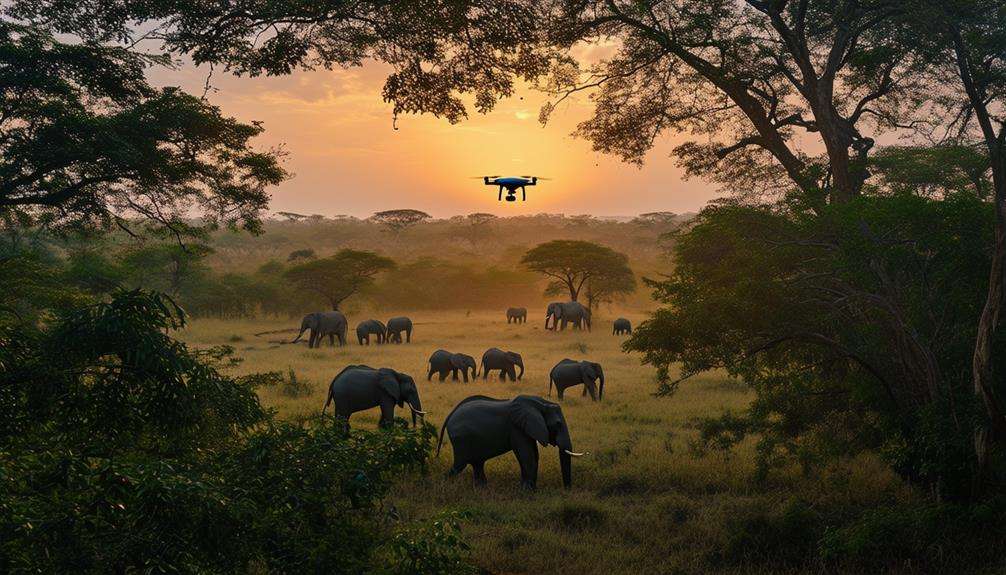
Drones significantly reduce human interaction with wildlife, making monitoring less intrusive and more effective. This technology allows researchers to observe animals without causing stress or harm, resulting in more accurate data and improved conservation outcomes.
Minimized Human Interaction
Using drones for wildlife monitoring allows you to collect crucial data on endangered species without disturbing their natural habitats. This technology minimizes human interaction, which is essential for preserving the delicate ecosystems where these species thrive. Drones enable you to observe and gather data from a distance, ensuring you don't intrude on their habitats or alter their natural behaviors.
Reducing human presence through drone technology helps maintain the natural routines and behaviors of endangered wildlife. By keeping your distance, you minimize stress and potential harm to the animals. This non-invasive approach allows you to capture more accurate and authentic data on their daily activities, mating rituals, and feeding habits.
Additionally, drones enhance conservation efforts by providing valuable insights that are difficult to obtain through traditional methods. You can monitor hard-to-reach areas and track movements without physically entering the terrain, thus protecting both the wildlife and your safety.
Drones offer a win-win solution for wildlife monitoring, enabling you to gather critical information while minimizing your impact on endangered species and their habitats.
Non-Intrusive Monitoring Techniques
Drones' non-intrusive monitoring techniques significantly reduce wildlife disturbance, making them invaluable for conservation efforts. By using drones, researchers can efficiently and safely monitor endangered species without causing undue stress or disrupting natural behaviors. This minimizes human interference, ensuring that the collected data is both accurate and reliable.
Traditional monitoring methods often involve a physical presence, which can disturb habitats and stress animals. In contrast, drones can capture detailed images and videos from high altitudes, allowing for in-depth understanding of species populations and behaviors while preserving habitat integrity.
Key benefits of using drones for non-intrusive monitoring include:
- Reduced Stress: Drones minimize the risk of startling or stressing animals, resulting in more natural behavior recordings.
- Accurate Data: Less disturbance ensures that data on endangered species is more dependable and reflective of true conditions.
- Efficient Monitoring: Drones can cover large areas quickly, enhancing the effectiveness of conservation projects.
Incorporating drones into wildlife conservation efforts improves our ability to protect endangered species and their habitats.
Stress-Free Observation Methods
Using drones for wildlife observation significantly reduces disturbance by minimizing human presence, ensuring that natural behaviors remain undisturbed. This non-invasive method is particularly valuable for monitoring endangered species, as it allows for accurate data collection without introducing stress.
Drones enable remote and discreet monitoring, eliminating the need for close physical proximity, which can be stressful for animals. This reduced disturbance results in data that more accurately reflects the true behaviors and conditions of the species, which is crucial for effective conservation strategies.
Furthermore, stress-free observation methods help create a safer environment for endangered species. When animals aren't stressed by human presence, they're less likely to engage in harmful behaviors or abandon their habitats. Thus, using drones aligns with the goals of wildlife conservation by promoting the health and stability of endangered populations without causing unnecessary stress.
Enhanced Data Collection
High-resolution cameras and advanced sensors equip drones with unparalleled capabilities for gathering critical data in wildlife conservation. Drones assist researchers in collecting essential information on endangered species, their habitats, and the threats they face. Utilizing technologies like thermal imaging allows for monitoring wildlife without disrupting their natural behaviors.
Drones offer several key advantages for enhanced data collection:
- Wide Coverage: Drones can efficiently survey large, remote areas that are challenging to access on foot, providing comprehensive data on wildlife populations and their environments.
- High Accuracy: The precision of drone-collected data enables accurate assessments of population trends and habitat conditions.
- Real-Time Monitoring: Real-time data transmission allows for immediate responses to potential threats, such as poaching or habitat destruction.
By using drones, researchers can gather detailed information crucial for formulating targeted conservation strategies. For instance, thermal imaging can locate and track animals in dense forests or during nighttime, ensuring well-informed conservation efforts. Leveraging these capabilities enhances the protection of wildlife and the effectiveness of conservation initiatives.
This advanced data collection is essential for informed decision-making and the implementation of effective measures to safeguard endangered species.
Cost-Effectiveness
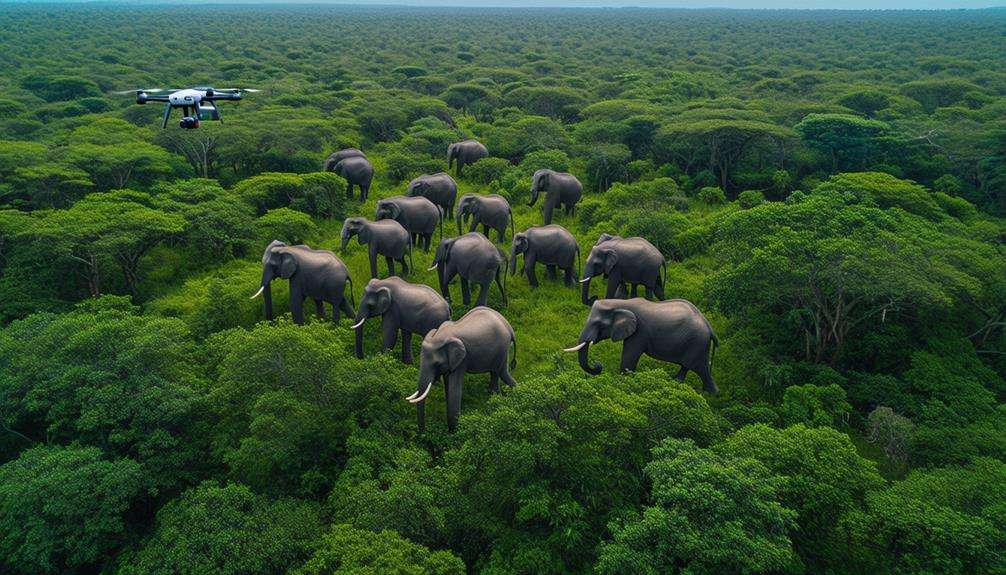
In addition to enhanced data collection capabilities, drones offer remarkable cost-effectiveness for wildlife conservation. Drone technology can reduce the costs of monitoring endangered species by up to 96% compared to traditional ground surveys due to significant reductions in manpower, time, and resources.
Rather than deploying large teams to remote and often inaccessible areas, drones can cover vast territories quickly and efficiently. Studies indicate that drone-based monitoring can save up to $300,000 annually, making it feasible to conduct ongoing data collection and ensure continuous monitoring of endangered species populations.
The affordability of drone technology democratizes access, enabling even smaller conservation organizations to benefit from advanced monitoring solutions. By investing in drones, funds can be reallocated to other critical areas such as habitat restoration and anti-poaching efforts.
The cost-effectiveness of drones not only makes them an attractive option but also strengthens the sustainability of conservation programs aimed at protecting endangered species. With these financial advantages, more resources can be focused on preserving the biodiversity that our planet urgently needs.
Researcher Safety
Using drones for wildlife conservation minimizes human-wildlife interaction, thereby reducing associated risks. Remote data collection enables monitoring of endangered species without venturing into hazardous terrains, ensuring both the safety of researchers and the integrity of the data gathered.
Minimizing Human-Wildlife Interaction
Drones have transformed wildlife conservation efforts by allowing researchers to study endangered species from a safe distance. This technology facilitates effective monitoring and provides remote access to habitats that are otherwise difficult and hazardous to reach, thereby minimizing disturbance to animals and reducing human-wildlife conflicts.
Drones enable the capture of high-resolution images and videos, offering valuable insights into animal behavior and migration patterns. This method collects data remotely, ensuring both researcher safety and the well-being of wildlife.
Here are key ways drones minimize human-wildlife interaction:
- Remote Monitoring: Drones allow for the observation and data collection of endangered species from a distance, minimizing the need for close human contact.
- Enhanced Safety: Using drones helps avoid dangerous situations, such as encounters with large or territorial animals.
- Non-Intrusive Observation: High-resolution cameras facilitate the study of animals without disrupting their natural behaviors, leading to more precise data collection.
Remote Data Collection
Leveraging drones for remote data collection significantly enhances researcher safety in challenging environments. When conducting fieldwork, safeguarding well-being is paramount, and drones take on the high-risk tasks, allowing researchers to concentrate on their core objectives.
With remote access, drones can effortlessly navigate difficult terrains, streamlining wildlife tracking and improving safety.
Equipped with high-resolution cameras, drones provide detailed insights into animal behavior and migration patterns. This technology enables the monitoring of endangered species from a distance, thereby minimizing human interference and stress on the animals. The real-time data collected is invaluable for understanding population dynamics and making informed conservation decisions.
Imagine collecting extensive data without stepping foot in potentially dangerous areas. Drones make this possible by flying over vast landscapes and capturing comprehensive data essential for research. This data forms a solid foundation for biodiversity protection.
Utilizing drones not only ensures researcher safety but also promotes the well-being of the species under study. Embracing this technology leads to more efficient and less hazardous research processes.
Wildlife Monitoring
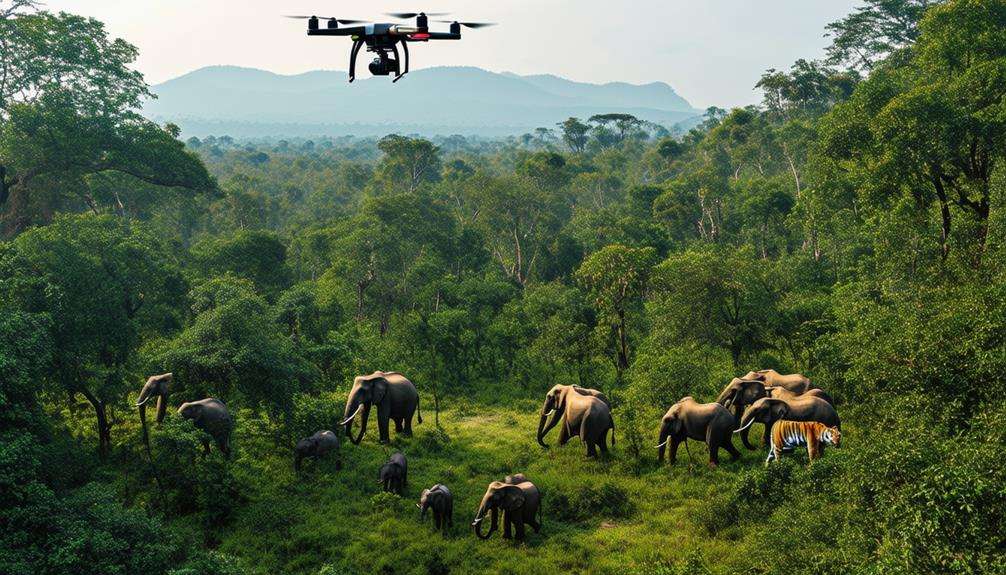
Thermal imaging technology in wildlife monitoring drones is transforming the way we track and protect endangered species. Thermal cameras can detect the heat signatures of animals, making it easier to locate even the most elusive creatures. This technology allows for efficient tracking and monitoring of wildlife, providing critical insights into their behavior and movement patterns.
Drones equipped with radio-telemetry systems can track multiple animals over vast areas simultaneously. This capability is crucial for understanding population dynamics and ensuring the survival of endangered species. By collecting real-time data, these drones offer valuable information about habitat usage, enabling informed conservation decisions.
Key benefits include:
- Enhanced Tracking: Thermal cameras enable precise tracking of wildlife, even in dense vegetation or low-light conditions.
- Behavioral Insights: Real-time data reveals critical information about animal behavior and interactions.
- Efficient Monitoring: Radio-telemetry systems facilitate the tracking of multiple animals simultaneously, covering large areas quickly.
Drone pilot training enhances your ability to efficiently collect data and track wildlife, ensuring that conservation efforts are effective. Leveraging these technologies significantly improves the monitoring and protection of endangered species.
Combatting Poaching
Advanced drone technology is revolutionizing the fight against poaching, providing a crucial tool for protecting endangered species from illegal hunting. Drones offer real-time surveillance of remote wildlife reserves, deterring poachers and safeguarding vulnerable animal populations.
Equipped with thermal imaging, drones can detect poachers in difficult-to-reach areas, even at night. The heat-sensing capabilities allow for spotting human activity in dense forests or vast savannas, significantly enhancing anti-poaching efforts. This technology is vital for tracking and intercepting illegal activities before they harm endangered species.
In addition to terrestrial applications, drones are also essential for monitoring marine life. They collect critical data on the movements and behaviors of species like whales, aiding in conservation efforts and preventing illegal whaling. Deploying drones for these purposes reduces wildlife crime and enhances the protection of endangered species.
Efficient Surveys
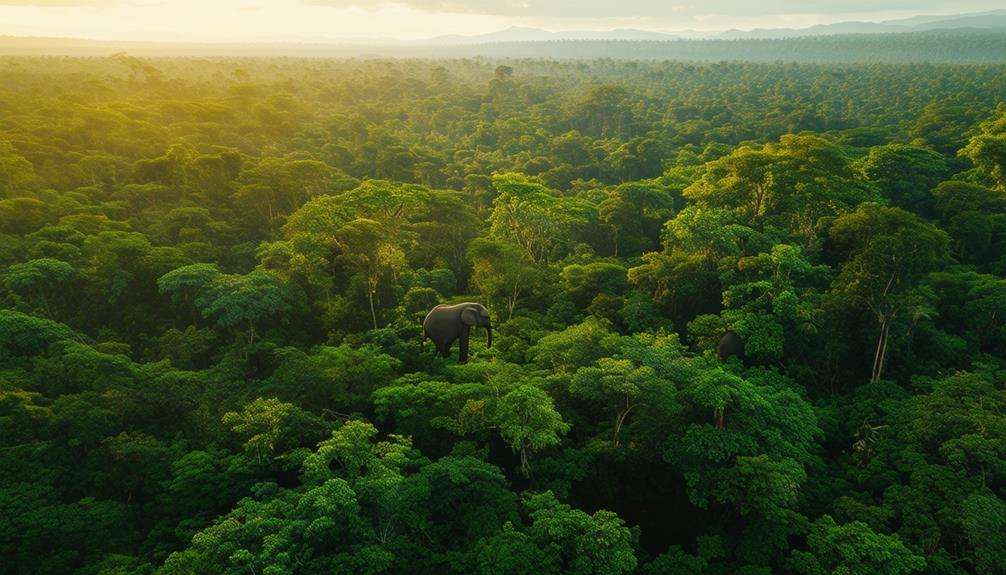
Beyond combatting poaching, drones excel in conducting efficient wildlife population surveys, significantly enhancing conservation efforts. Utilizing advanced thermal imaging, drones can accurately monitor endangered species in challenging environments like South Texas. This technology enables the collection of vital data on the health and population dynamics of these species, which is essential for effective conservation planning.
With drones, you can:
- Monitor Habitat Use: Thermal drones offer valuable insights into how endangered species utilize their habitats, aiding in the understanding of their behavior and needs.
- Assess Population Distribution: Drones provide detailed information on species' distribution and abundance, facilitating the identification of areas requiring immediate conservation action.
- Conduct Non-Intrusive Surveys: Drones enable wildlife surveys without causing disturbances, ensuring accurate data collection without impacting natural behavior.
This approach ensures data accuracy, supports effective conservation strategies, and maintains the integrity of wildlife habitats.
Recommended Drones
Let's explore top drone models like the JOUAV CW-25E VTOL and JOUAV PH-7E Quadcopter, known for their high payload capacity and extended flight time. We'll provide an overview of their key features, including specialized cameras and sensors. Additionally, we'll highlight some budget-friendly options for effective wildlife monitoring.
Top Drone Models
When selecting drones for wildlife conservation, certain models excel due to their advanced features and reliability, aiding in the collection of critical data, tracking endangered species, and precise wildlife monitoring.
- DJI Phantom 4 Pro V2.0: This drone's advanced camera capabilities allow for capturing detailed images and videos, enhancing the ability to track wildlife and gather crucial data.
- Autel Robotics EVO II Pro: Equipped with high-resolution imaging and thermal sensors, this drone is ideal for monitoring endangered species in diverse environments.
- WingtraOne VTOL: Its vertical takeoff and landing capabilities, combined with mapping features, make it perfect for monitoring wildlife in remote and challenging locations.
Additionally, the Parrot Anafi USA is notable for its compact design and versatile applications. Its 32x zoom camera and thermal imaging options provide detailed insights into wildlife behavior and habitats.
Moreover, the senseFly eBee X offers extended flight times, multispectral imaging, and 3D mapping, making it a comprehensive tool for wildlife research and monitoring.
Choosing the right drone can significantly enhance your conservation efforts, allowing for more efficient data collection and accurate wildlife tracking. These top models deliver the technology and reliability essential for successful wildlife conservation projects.
Key Features Overview
To maximize the impact of your conservation efforts, it's crucial to understand the key features of recommended drones. When monitoring endangered species, you need drones equipped with advanced technology and versatile features. For instance, the JOUAV CW-25E VTOL Drone offers silent operation and a high payload capacity, ideal for minimizing wildlife disturbance. Its capability to cover large areas quickly ensures efficient wildlife conservation.
The JOUAV PH-7E Quadcopter features dual gimbal camera systems and extended flight times, providing excellent image quality and prolonged observation periods. These drones can operate in both infrared and visible light modes, facilitating effective day and night monitoring. Precision control and superior maneuverability enable accurate data collection across diverse terrains, which is essential for tracking endangered species in their natural habitats.
Additionally, these drones can track up to 40 animals simultaneously, offering extensive monitoring capabilities. They can rapidly cover challenging landscapes, ensuring critical data points aren't missed.
With these key features, wildlife monitoring drones like the JOUAV models enhance your ability to gather essential information, ultimately supporting your conservation efforts to protect endangered species effectively.
Budget-Friendly Options
Looking for cost-effective drones that deliver essential features for wildlife conservation? You're in luck! Several budget-friendly options are available to help you monitor endangered species without breaking the bank.
One standout is the DJI Mini 2. Despite its compact size, this drone offers a 4K camera, making it ideal for capturing high-resolution images and videos critical for tracking wildlife. It's lightweight and easy to transport, perfect for fieldwork.
Another excellent choice is the Autel Robotics EVO Lite +. This drone combines affordability with advanced features like obstacle avoidance and long battery life, ensuring you can cover more ground safely and efficiently during your conservation projects.
For those seeking an even more economical option, the Holy Stone HS720E delivers impressive performance. It includes GPS-assisted flight and a high-quality camera, providing reliable monitoring capabilities for your conservation efforts.
Here are three budget-friendly options to consider:
- DJI Mini 2: Compact, 4K camera, lightweight.
- Autel Robotics EVO Lite +: Obstacle avoidance, long battery life.
- Holy Stone HS720E: GPS-assisted flight, high-quality camera.
These drones offer essential features for wildlife conservation, helping you monitor endangered species effectively without overspending.
Conclusion
Drones are revolutionizing wildlife conservation by providing efficient and non-intrusive monitoring methods. They minimize disturbances to animals, enhance data collection, and reduce costs.
By utilizing various types of drones, conservationists can locate and protect endangered species more effectively. Additionally, drones combat poaching and conduct efficient surveys, significantly impacting the preservation of vulnerable wildlife and their habitats.
Embracing drone technology contributes to a brighter future for endangered species.

